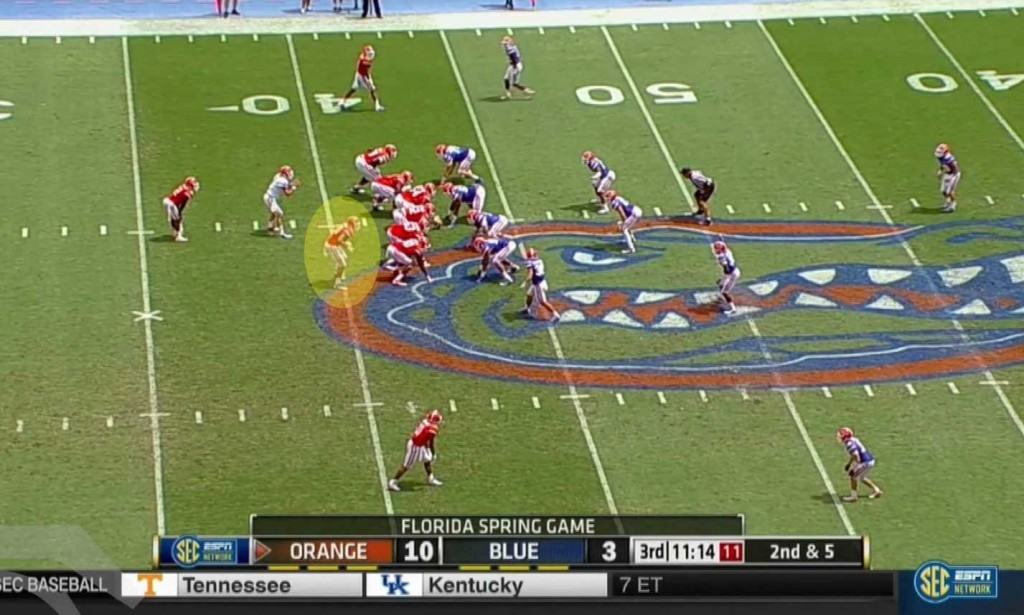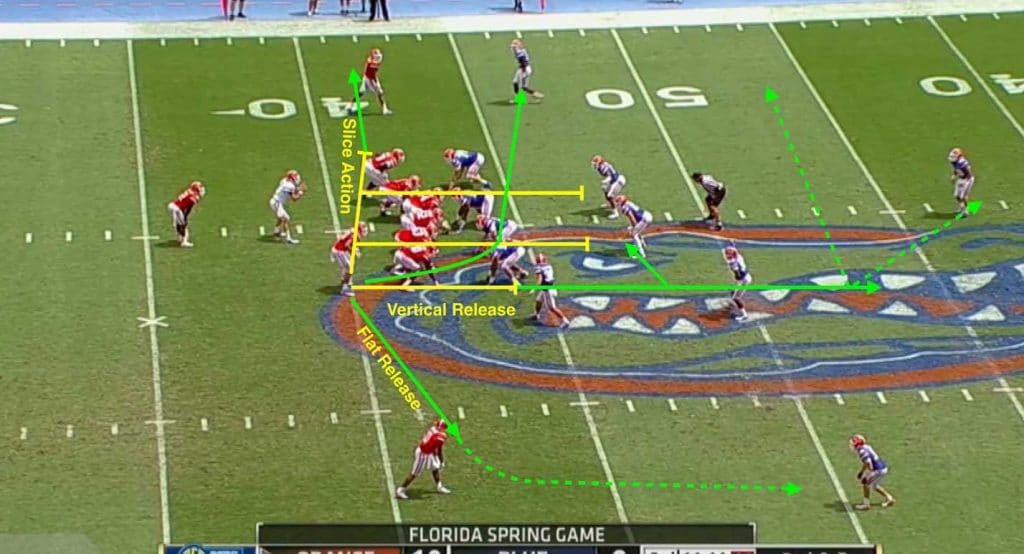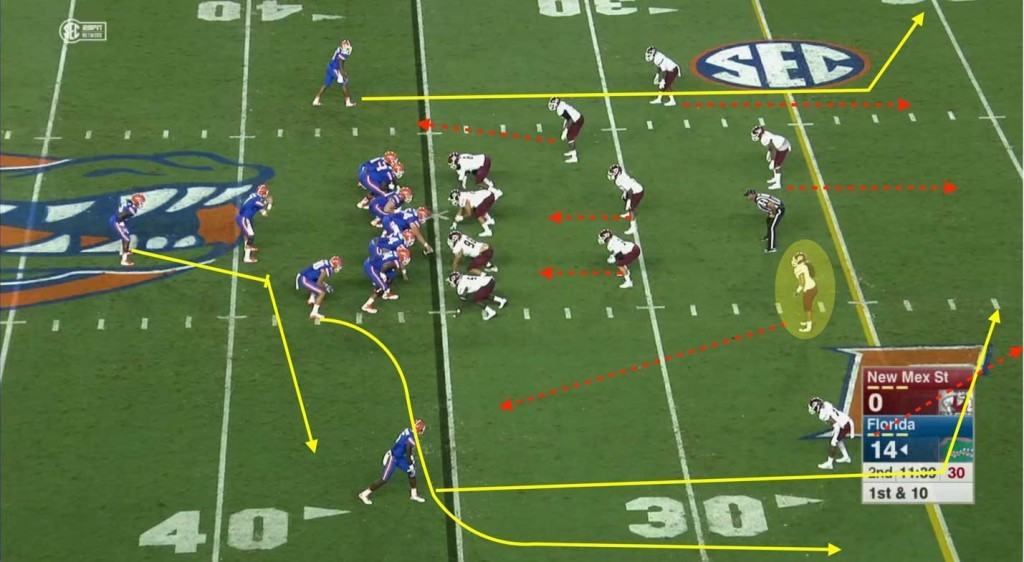Multiple McElwain
If there is one thing we have learned about Florida Gators coach Jim McElwain since Jeremy Foley brought him in to inject life into the Florida Football program, it is that Coach Mac is a very resourceful guy. This has been evident through his rather remarkable closing leading up to signing day, his assembling a really terrific staff, and his somehow managing to turn 6 healthy scholarship linemen into a 2-deep and then some in the span of a summer. He got dealt a rather poor hand and clearly made the most of it. Likewise, Coach Mac has historically managed to make the most of what he had with his offenses at his previous stops at a coordinator and head coach.
While his offenses have looked a bit different at Alabama and at Colorado State, they do have a few constants:
1) A primarily single back zone-based run scheme
2) A well-structured layered passing scheme that simplifies decision-making for his quarterbacks
3) Well-timed constraint plays that punish a defense for not playing straight-up
4) A willingness to throw or run on any down
5) Using flex positions (below) dynamically to confuse defensive keys
That last point is how Mac really puts his stamp on his offenses. At past stops, he’s used tight ends such as Brad Smelley at Alabama as dynamic multi-dimensional threats that stress the run/pass assignments of the opposing team’s front 7 and seam/curl/flat players with multiple options from the same look. They are never the leading receiver in Mac’s offense, but they are possibly the most important position on the field to really make the offense go, due to the sheer number of ways a defense must account for them not only in the passing game, but in their gap assignments and run fits.
Out of slice action, they can slice block the backside player on a zone run, run the flat on play action, or insert block on a linebacker in the interior, producing an extra gap that the defense must account for and surprising a linebacker expecting a clean hole. These type of blocks take advantage of superior leverage and an element of surprise rather than asking a weaker blocker to take on a defensive end directly. They are effort assignments rather than ability assignments.
Out of a vertical release, they can block an outside linebacker or safety, cut the release short into a drag across the field, or run any number of seam read-type routes to bust single safety looks with 8 in the box.
Out of a flat release, they can serve as an outlet when the pocket breaks down, or turn up the field on a wheel route to put vertical pressure on less mobile flat defenders.
The cut up below from the first 2 weeks shows several of these options in action:
Look for more tight end usage in the coming weeks, and more wrinkles in their assignments.
Running the Wheel
One particular area of success the first 2 weeks has been the wheel route. Will Grier and Treon Harris have both thrown this route for big gains. This route has been so effective because of the abundance of essentially man coverage responsibilities we’ve seen so far. At the college level, asking a linebacker to laterally cover the flats and then flip their hips and push vertical is just asking for that linebacker to get burned. It’s possibly even worse when you ask a safety to play downhill in a Sky rotation (football shorthand for when the strong safety has flat/run force responsibilities) or in cover zero with no safety help over the top. See the cutup below for examples of how we’ve had success with the route against different coverage types.
Essentially what the wheel route does is force the flat defender to cover a receiver man to man and rotate their hips to change direction drastically without being able to count on help over the top from a safety. This is due to the way McElwain likes to structure this pattern trailing a post from the outside receiver to take the top off the defense and with the running back leaking into the flat behind the wheel. It’s essentially a three tier flood pattern that punishes defenses for playing the flat (outlet) routes and the run game aggressively.
On this particular play against New Mexico State which gained 23 yards, the strong safety located inside of 10 yards and outside of the hash is giving away the sky rotation. The post clears out for the wheel route, which is thrown more like a fade against cover 2. That is, it is more of a line drive at 20-22 yards in the hole underneath the deep third corner and the closing free safety than 30 yard throw over the outside shoulder that Spurrier was so fond of, and both of our quarterbacks have thrown the route superbly this fall.
The Quarterback Battle
Speaking of our quarterbacks, it is my opinion that Mac has managed this battle about as well as he could on the whole. That said, I’m in agreement with the statistics that say that both Grier and Harris perform notably better when they’re in the game consistently and markedly worse when they come in cold. A decision needs to be made soon, and to me the answer going forward is fairly clear.
To this point, the competition has been fairly close with Treon showing significant improvement in his throwing mechanics and both moving the ball fairly well. That said, the manner in which these two candidates are moving the ball gives me cause for concern and really can be exemplified by a couple of plays. Take a look at the cut up below, featuring Treon executing a relatively simple 3 level flood read and Will executing a read of the McElwain staple variation of a Mesh play.
While Treon does bring mobility and ability to extend a play to the table, that kind of advantage will be less of a factor in SEC play against better, more disciplined defenses that won’t break down as often and will be able to force our QBs to beat them through the air. Treon’s issues getting through his progressions will begin to rear their head as they did against South Carolina, FSU, and in the bowl game against ECU last year and ultimately will limit the ability of Jim McElwain’s heavily timing-based passing offense from being as successful as it can. I still think Will Grier is likely to have some growing pains getting accustomed to the ability of SEC defenses to disguise coverages and show him things he hasn’t seen, in addition to perhaps a bit of Grossman-esque overconfidence in his arm at times. Ultimately, though, his natural ability to anticipate open receivers and his better arm talent give him a significantly better chance of moving the ball when the defense has taken away the option to extend the play, and thus a higher ceiling than Treon.






Love these kind of articles. Keep them coming.
Now this article, a lot of meat there, a lot of substance. Thank you, we appreciate you taking the time to break it down. And I for one am just glad there’s finally something to break down on the offensive side of the ball, it’s been awhile.